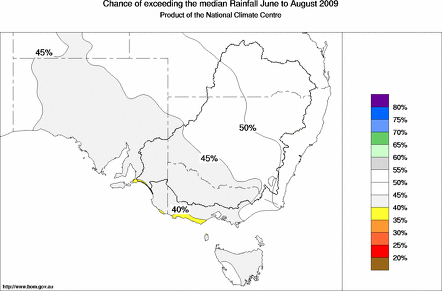| Southeastern Aust Seasonal Rainfall Outlook: probabilities for Winter 2009, issued 26th May 2009 | |||||||||
No significant shifts in winter rainfall odds for southeastern AustraliaFor southeastern Australia, the outlook for total rainfall over winter (June to August), shows no strong shifts in the odds favouring either wetter or drier conditions. This means the chances of above normal rainfall is about the same as the chance of below normal. The pattern of seasonal rainfall odds across southeastern Australia is a result of recent warm conditions in the Indian Ocean and an increasing level of warmth in the Pacific. In most of the southeast, the influences from both these oceans provide a very slight bias toward drier conditions, but in northeastern NSW a Pacific Ocean pattern that promotes drier conditions is countered by a Indian Ocean pattern promoting a wetter than normal season. 
For the June to August period, the chance of exceeding median rainfall is between 40 and 50% over nearly the whole of the southeastern region (see map). This means that for every ten years with ocean patterns like the current, about four or five years are expected to be wetter than average during winter, while about five or six years are expected to be drier. In a few small patches along the southern coast of South Australia and Victoria, the chances of a wetter than normal winter drop below 40% indicating an increased risk of dry conditions. New: Under the WATL part of the Bureau's website, there is an expanded set of seasonal rainfall outlook maps and tables, including the probabilities of seasonal rainfall exceeding given totals (e.g. 200 mm). Outlook confidence is related to how consistently the Pacific and Indian Oceans affect Australian rainfall. During winter, history shows this effect to be moderately consistent over most of northern NSW, large areas of Victoria, parts of the pastoral districts and far northeast of SA and the southeast coastal strip of Tasmania. However, confidence is only weakly to very weakly consistent in a band stretching from northwest South Australia, through southern NSW to eastern Victoria. Confidence is also weakly consistent in a second band extending along the southern coast of SA to western Victoria and the west coast of Tasmania Recent trends in Pacific climate patterns and the latest outputs from computer models indicate an increased risk of an El Niño developing during winter and spring. The SOI is approximately −11 for the 30 days ending 23 May. For routine updates and comprehensive discussion on any developments please see the ENSO Wrap-Up. | |||||||||
Click on the map above for a larger version of the map. Use the reload/refresh button to ensure the latest forecast map is displayed. More detailed forecast maps, including the probabilities of seasonal rainfall exceeding given totals, can be found here. | |||||||||
|
More information on this outlook is available Monday to Friday from 9.00am to 5.00pm local time by contacting the Bureau's Climate Services sections in Queensland, NSW, SA, Victoria and Tasmania at the following numbers:
| |||||||||
THE NEXT ISSUE OF THE SEASONAL OUTLOOK IS EXPECTED BY 23rd June 2009 Corresponding temperature outlook | |||||||||
Background Information
| |||||||||









